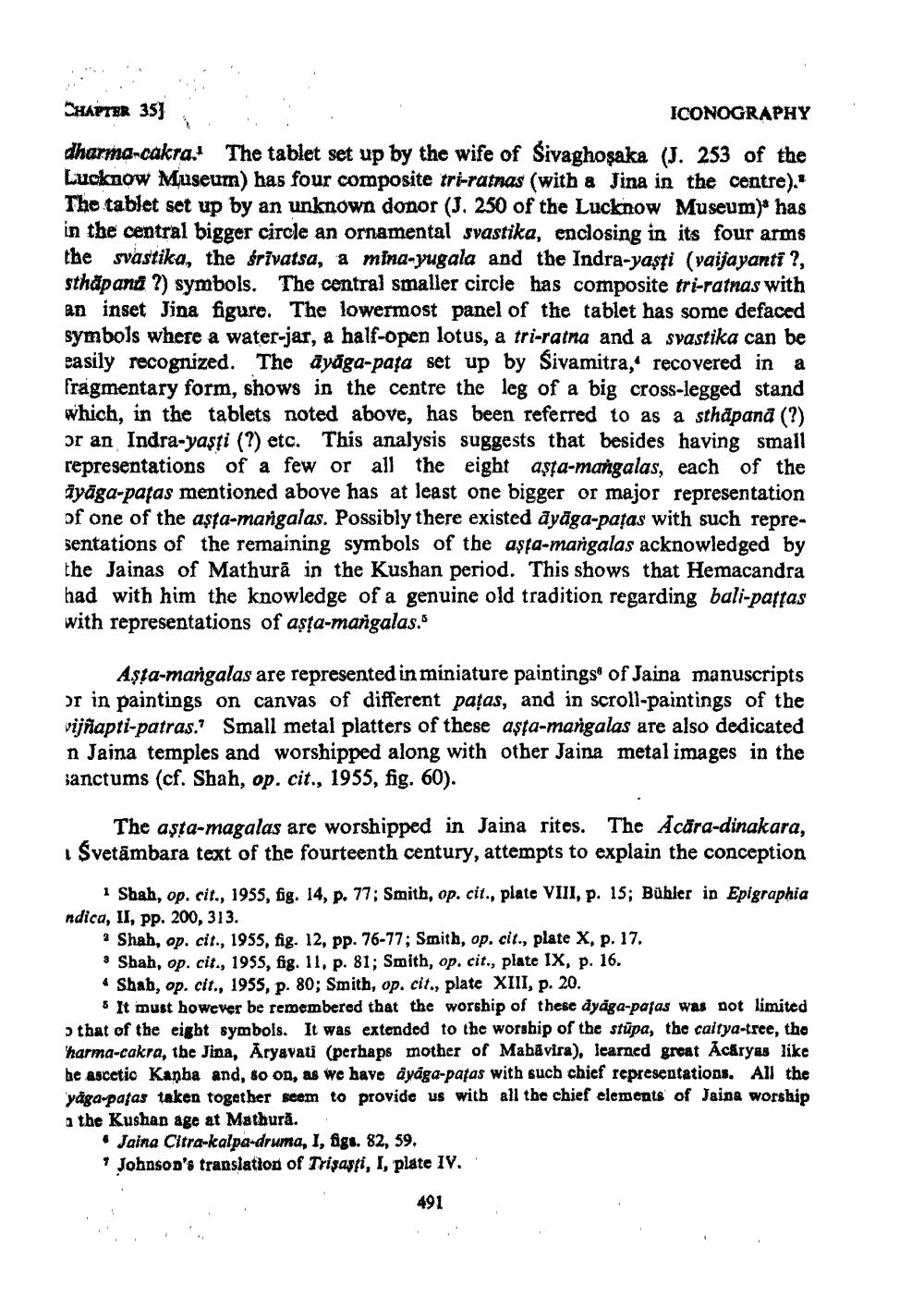________________
CHAPTER 353 .
ICONOGRAPHY dharma-cakra. The tablet set up by the wife of Sivaghosaka (J. 253 of the Lucknow Museum) has four composite tri-ratnas (with a Jina in the centre)." The tablet set up by an unknown donor (J. 250 of the Lucknow Museum) has in the central bigger circle an ornamental svastika, enclosing in its four arms the svastika, the srivatsa, a mina-yugala and the Indra-yaşti (vaijayanti ?, sthāpand ?) symbols. The central smaller circle has composite tri-ratnas with an inset Jina figure. The lowermost panel of the tablet has some defaced symbols where a water-jar, a half-open lotus, a tri-ratna and a svastika can be easily recognized. The dyaga-paga set up by Sivamitra, recovered in a fragmentary form, shows in the centre the leg of a big cross-legged stand which, in the tablets noted above, has been referred to as a sthapana (?) or an Indra-yaşți (?) etc. This analysis suggests that besides having small representations of a few or all the eight aşta-mangalas, each of the ayāga-pafas mentioned above has at least one bigger or major representation of one of the aşta-mangalas. Possibly there existed dyāga-pațas with such representations of the remaining symbols of the aşta-mangalas acknowledged by the Jainas of Mathura in the Kushan period. This shows that Hemacandra had with him the knowledge of a genuine old tradition regarding bali-pastas with representations of asta-mangalas."
Aşta-mangalas are represented in miniature paintings of Jaina manuscripts or in paintings on canvas of different patas, and in scroll-paintings of the vijñapti-patras.' Small metal platters of these aşta-mangalas are also dedicated n Jaina temples and worshipped along with other Jaina metal images in the sanctums (cf. Shah, op. cit., 1955, fig. 60).
The aşta-magalas are worshipped in Jaina rites. The Acara-dinakara, Svetāmbara text of the fourteenth century, attempts to explain the conception
1 Shah, op. cit., 1955, fig. 14, p. 77; Smith, op. cit., plate VIII, p. 15; Bühler in Epigraphia ndica, II, pp. 200, 313.
? Shah, op. cit., 1955, fig. 12, pp. 76-77; Smith, op. cit., plate X, p. 17. 3 Shah, op. cit., 1955, fig. 11, p. 81; Smith, op. cit., plate IX, p. 16. • Shah, op. cit., 1955, p. 80; Smith, op. cit., plate XIII, p. 20.
* It must however be remembered that the worship of these dyaga-pafas was not limited o that of the eight symbols. It was extended to the worship of the stūpa, the caltya-tree, the harma-cakra, the Jina, Aryavati (perhaps mother of Mabavira), learned great Acaryas like be ascetic Kanha and, so on, as we have ayaga-patas with such chief representations. All the yaga-pafas taken together seem to provide us with all the chief elements of Jaina worship a the Kushan age at Mathură.
• Jaina Citra-Kalpa-druma, I, figs. 82, 59. * Johnson's translation of Trisasti, I, plate IV.'
491




